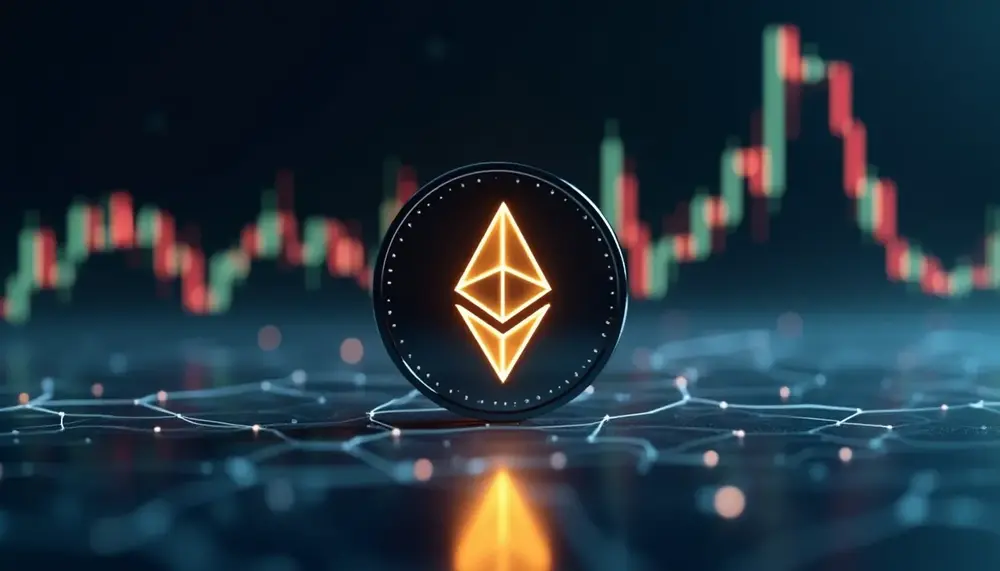
Coin bezogen
Preis-Rechner
Preisverlauf
Preisprognose
Technische Analyse
Leitfaden zum Kauf von Coins
Kategorie Krypto
Gewinn-Rechner

Ethereum Kurs ETH
Wie denken Sie heute über Ethereum?
Preis von Ethereum heute
Was ist der höchste Preis von ETH?
Was ist der niedrigste Preis von ETH?
Warum schwankt der Preis von ETH ständig? Welche Faktoren beeinflussen die Entwicklung der Preise von ETH?
Ethereum Preisprognose
Wann ist ein guter Zeitpunkt, um ETH zu kaufen? Sollte ich ETH jetzt kaufen oder verkaufen?
Wie hoch wird der Preis von ETH in 2026 sein?
Wie hoch wird der Preis von ETH in 2031 sein?
Ethereum Preisverlauf (EUR)
 Niedrigster Preis
Niedrigster Preis Höchster Preis
Höchster Preis 
Ethereum Markt-Informationen
Ethereum Verlauf der Marktkapitalisierung
Ethereum Markt
Ethereum Bestände
Ethereum Bestandsverteilungsmatrix
Ethereum Bestände nach Konzentration
Ethereum Adressen nach Haltezeit

Ethereum Bewertungen
Über Ethereum (ETH)
Ethereum ist die Blockchain der zweiten Generation, die die Erstellung und den Betrieb von dezentralisierten Anwendungen (dApps) und Smart Contracts ermöglicht Sie wurde 2015 von Vitalik Buterin entwickelt und ist vor allem dafür bekannt, Smart Contracts in die Welt der Blockchain zu bringen. Die Kosten für jede Transaktion und die Ausführung von Smart Contracts auf Ethereum werden in Gas gemessen.
Mit dem größten Ökosystem an dApps dient Ethereum auch als Rückgrat für viele Layer-2-Lösungen, wie z. B. Arbitrum und Polygon die eine schnellere und kostengünstigere Transaktionsverarbeitung ermöglichen.
Was ist Ethereum (ETH)?
Ethereum ist nach Marktkapitalisierung die zweitgrößte Kryptowährung hinter Bitcoin. Sie wurde vom russisch-kanadischen Programmierer Vitalik Buterin entwickelt und am 30. Juli 2015 offiziell eingeführt. Ether, die native Kryptowährung von Ethereum, treibt das Ökosystem an, indem sie Transaktionen ermöglicht, Smart Contracts ausführt und Knotenpunkte für Rechenressourcen entschädigt. Gwei ist eine kleinere Einheit von Ether, wobei ein Gwei 0,000000001 ETH (ein Milliardstel eines ETH) entspricht.
Ethereum wurde im Rahmen eines Initial Coin Offering (ICO) zwischen dem 22. Juli und dem 2. September 2014 eingeführt. Während des ICO konnten die Teilnehmer Ether (ETH) mit Bitcoin (BTC) zu einem Kurs von 2000 ETH pro BTC kaufen - etwa 0,31 US-Dollar pro ETH. Das ICO brachte über 18 Millionen US-Dollar ein und war damit eines der erfolgreichsten Fundraising-Events in der Welt der Kryptowährungen. Seit seiner Gründung bietet Ethereum Entwicklern und Nutzern ein dezentralisiertes Netzwerk für die Erstellung und Interaktion mit Blockchain-basierten Anwendungen, ohne auf zentrale Vermittler angewiesen zu sein.
Wer hat die Ethereum-Blockchain gegründet?
Ethereum hatte acht Mitbegründer:
• Vitalik Buterin - Der Hauptvisionär, der das Whitepaper von Ethereum verfasst hat.
• Gavin Wood - hat das Yellow Paper verfasst und die Programmiersprache Solidity entwickelt.
• Joseph Lubin - Gründer von ConsenSys, einem Unternehmen für Blockchain-Technologie.
• Anthony Di Iorio - Ein früher Investor in Ethereum.
• Mihai Alisie - War an der Gründung der Ethereum Foundation beteiligt.
• Amir Chetrit - Ein früher Mitwirkender, der sich später aus dem Projekt zurückzog.
• Charles Hoskinson - Mitbegründer von Ethereum, der später die Cardano-Blockchain gründete.
• Jeffrey Wilcke - Ein wichtiger Entwickler hinter Go Ethereum (Geth).
Im Jahr 2024 ist Vitalik Buterin der einzige Mitbegründer, der noch aktiv an Ethereum arbeitet. Die anderen sind weitergezogen, um neue Blockchain-Unternehmungen zu leiten oder zu gründen.
Die Geschichte von Ethereum
2013: Vitalik Buterin, ein Mitbegründer des Bitcoin Magazine, schlug Ethereum vor. Er stellte sich eine Blockchain-Plattform für dezentralisierte Anwendungen (dApps) vor, die von Smart Contracts angetrieben werden.
2014: Ethereum wurde auf der nordamerikanischen Bitcoin-Konferenz angekündigt. Sein Initial Coin Offering (ICO) brachte über 18 Millionen US-Dollar ein.
2015: Ethereum brachte am 30. Juli seine erste Live-Version, Frontier, auf den Markt und ermöglichte es Entwicklern, dApps zu erstellen.
2016: Ethereum erfährt sein erstes Upgrade, Homestead, und wird mit dem DAO-Hack konfrontiert, was zu einer Hard-Fork führt, die das Netzwerk in Ethereum (ETH) und Ethereum Classic (ETC) aufteilt.
2017: Das Byzantium Upgrade verbesserte den Datenschutz und die Skalierbarkeit mit neun Ethereum Improvement Proposals (EIPs).
2019: Mit den Upgrades Konstantinopel und Istanbul wurden die Gaskosten optimiert, die Interoperabilität erhöht und die Effizienz des Zero-Knowledge-Proofs verbessert.
2020: Ethereum startet die Beacon Chain und führt Proof-of-Stake (PoS) als Teil der Ethereum 2.0 Roadmap ein.
2021: Die Hard-Fork-Upgrades Berlin und London optimieren die Gebühren und führen EIP-1559 ein, wodurch ein Teil der Transaktionsgebühren verbrannt wird.
2022: Ethereum ist mit The Merge am 15. September auf PoS umgestiegen, was den Energieverbrauch um ~99,95 % reduziert.
2023: Die Upgrades von Shanghai und Capella ermöglichten Staked ETH-Auszahlungen und optimierte PoS-Prozesse.
2024: Ethereum konzentriert sich weiterhin auf Skalierungslösungen wie Sharding, um die Transaktionsgeschwindigkeit zu erhöhen und die Kosten zu senken.
So funktioniert Ethereum
Ethereum ist eine dezentralisierte, quelloffene Blockchain-Plattform, auf der Entwickler Smart Contracts erstellen und ausführen können - selbstausführende Programme, die eine breite Palette dezentralisierter Anwendungen (dApps) betreiben. Sie funktioniert über ein globales Netzwerk von Computern (Knotenunkte/Nodes), die Transaktionen verarbeiten und in der Blockchain aufzeichnen, was Sicherheit und Transparenz gewährleistet. Die Ethereum-eigene Kryptowährung Ether (ETH) wird verwendet, um Gasgebühren für Transaktionen zu bezahlen, Smart Contracts auszuführen und das Netzwerk durch Staking zu unterstützen.
Nachdem Ethereum im Jahr 2022 auf Proof-of-Stake (PoS) umgestellt wurde, ersetzten Validatoren die Miner, um das Netzwerk zu sichern. Um Validator zu werden, müssen Sie 32 ETH einsetzen, die gesperrt sind, um die Sicherheit und Effizienz des Netzwerks zu gewährleisten. Im Gegenzug erhalten die Validierer Anreize für die Überprüfung und Hinzufügung neuer Blöcke.
Was macht Ethereum einzigartig?
Mit über einer Million Tokens, die auf seiner Blockchain aufgebaut sind, und Milliarden von Dollar, die durch dezentralisierte Anwendungen (dApps) fließen, hat Ethereum die Möglichkeiten der Blockchain-Technologie neu definiert. Es unterstützt ERC-20-Tokens wie USDT, LINK und BNB, von denen viele nach Marktkapitalisierung zu den Top-Kryptowährungen zählen. Ethereum treibt auch den florierenden Markt für nicht-fungible Tokens (NFT) an, der einzigartige digitale Assets in den Bereichen Gaming, Kunst und mehr ermöglicht. Das EIP-1559-Upgrade fügte seinem Ökosystem ein deflationäres Element hinzu, indem es einen Teil der Gasgebühren verbrannte und damit sein Wirtschaftsmodell weiter stärkte.
Mit dem weltweiten Interesse, das sich in Handelspaaren wie ETH zu USD und ETH zu EUR widerspiegelt, ist Ethereum weiterhin führend in der Gestaltung der Zukunft der Blockchain.
Was ist das nächste Ethereum-Upgrade?
Was ist das Ethereum 2.0-Upgrade?
Ethereum 2.0 ist eine umfassende Aktualisierung der Ethereum-Blockchain, die in mehreren Phasen eingeführt wird, beginnend mit der Beacon Chain im Dezember 2020. Die bemerkenswerteste Änderung war der Übergang von Proof-of-Work (PoW) zu Proof-of-Stake (PoS ) beim sogenannten The Merge, der im September 2022 abgeschlossen wurde. Durch diese Umstellung konnte der Energieverbrauch erheblich gesenkt und die Sicherheit des Netzwerks verbessert werden.
Ethereum Pectra Upgrade
Das nächste große Ethereum-Upgrade, Prague-Electra (Pectra), ist für Anfang 2025 geplant. Es wird die Skalierbarkeit, Effizienz und Benutzerfreundlichkeit durch Schlüsselfunktionen wie Batch-Transaktionen (EIP-3074), erhöhte Einsatzgrenzen (EIP-7251) und reduzierten Knotenspeicher über Verkle Trees (EIP-2935) verbessern. Erfahren Sie mehr über das Pectra-Upgrade und wie es Ihr Ethereum-Erlebnis verbessern wird.
Beeinflusst das Ethereum-Upgrade den Preis von ETH?
Ethereum-Upgrades können den Preis von ETH beeinflussen, aber die Auswirkungen sind nicht immer eindeutig. Bedeutende Upgrades, wie The Merge im Jahr 2022, wecken in der Regel das Interesse des Marktes und können zu Preisschwankungen führen, einschließlich Änderungen des Ethereum-Live-Preises. Diese Upgrades zielen darauf ab, die Skalierbarkeit, Sicherheit und Energieeffizienz des Netzwerks zu verbessern, was als positive Entwicklung für die langfristigen Aussichten von Ethereum gesehen werden kann. Kursänderungen werden jedoch auch von anderen Faktoren beeinflusst, wie z. B. den allgemeinen Marktbedingungen und der Stimmung der Anleger, so dass die Auswirkungen von Upgrades auf den ETH-Kurs nicht immer vorhersehbar sind.
Um einen Einblick in Echtzeit zu erhalten, verfolgen viele Händler den aktuellen ETH-Kurs zusammen mit Ethereum-Charts, um kurzfristige Schwankungen und das Marktverhalten besser zu verstehen.
Was sind mögliche Anwendungsfälle für Ethereum?
Ethereum ermöglicht aufgrund seiner Flexibilität und dezentralisierten Natur eine Vielzahl von Anwendungsfällen:
• Dezentralisierte Finanzen (DeFi): Finanzdienstleistungen ohne Intermediäre (z. B. Kreditvergabe, Börsen).
• Smart Contracts: Automatisierte Vereinbarungen in Branchen wie Versicherungen, Immobilien und Recht.
• Nicht-fungible Token (NFTs): Digitales Eigentum an Kunst, Sammlerstücken und Medien.
• Dezentralisierte autonome Organisationen (DAO): Organisationen, die von der Community verwaltet werden.
• Lieferkettenmanagement: Transparente Verfolgung der Waren und Überprüfung der Echtheit.
• Spiele: Play-to-Earn-Modelle (P2E) und tokenisierte Assets in Spielen.
• Identitätsüberprüfung: Sichere Verwaltung von digitalen Identitäten und persönlichen Daten.
Wo kann ich mich über Neuigkeiten zu Ethereum informieren?
Wenn Sie auf der Suche nach den neuesten Bitcoin-Updates und Krypto-Nachrichten sind, ist Bitget die richtige Adresse. Bitget News hält Sie mit Echtzeit-Updates, Markttrends und den neuesten Ereignissen in der Kryptowelt auf dem Laufenden
Sind Sie bereit, mehr zu erfahren? Bitget Academy ist der perfekte Ort, der einfache Anleitungen, Handelstipps und Einblicke sowohl für Anfänger als auch für erfahrene Trader bietet.
Wie geht es mit Ethereum weiter?
Mit Blick auf die Zukunft wird die Entwicklung von Ethereum fortgesetzt, wobei der Schwerpunkt auf der Verbesserung der Skalierbarkeit, der Sicherheit und der Dezentralisierung liegt:
• Sharding - Ein großes Update, das Ethereum in kleinere Teile (Shards) aufteilt, um Transaktionen parallel zu verarbeiten, was die Geschwindigkeit erhöht und die Gebühren senkt.
• Layer-2-Lösungen - Technologien wie Optimism und Arbitrum werden die Transaktionskosten weiter senken und die Skalierbarkeit verbessern.
• EIP-4844 (Proto-Danksharding) - Damit werden neue Transaktionsarten eingeführt, um die Gasgebühren weiter zu senken und die Datenverfügbarkeit zu verbessern.
• EVM-Verbesserungen - Verbesserungen an der Ethereum Virtual Machine werden die Leistung steigern und komplexere Anwendungen unterstützen.
• PoS-Optimierungen - Laufende Verbesserungen am Proof-of-Stake-System von Ethereum erhöhen die Sicherheit, die Dezentralisierung und die Staking-Anreize.
Beginnen Sie zu investieren, indem Sie auf die Ethereum Trading-Seite auf Bitget gehen. Der Preis von Ethereum wird aktualisiert und ist in Echtzeit auf Bitget verfügbar.
ETH in lokaler Währung
- 1
- 2
- 3
- 4
- 5
Wie man Ethereum(ETH) kauft

Erstellen Sie Ihr kostenloses Bitget-Konto

Verifizieren Sie Ihr Konto

Ethereum in ETH konvertieren
ETH-Perpetual-Futures traden
Nachdem Sie sich erfolgreich bei Bitget angemeldet und USDT oder ETH Token gekauft haben, können Sie mit dem Trading von Derivaten beginnen, einschließlich ETH Futures und Margin-Trading, um Ihr Einkommen zu erhöhen.
Der aktuelle Preis von ETH ist €1,655.52, mit einer 24h-Preisänderung von -1.46%. Trader können von Futures profitieren, indem sie entweder Long- oder Short-Positionen eingehen.
Schließen Sie sich ETH Copy-Trading an, indem Sie Elite-Tradern folgen.
Ethereum Nachrichten


Zusammenfassung des Artikels Ethereum-Layer-2-Lösungen fördern Skalierung und Innovation, belasten jedoch das Mainnet wirtschaftlich durch geringere ETH-Nutzung und Gebühreneinnahmen.

Zusammenfassung des Artikels Ethereum verliert seit der Umstellung auf PoS massiv Marktanteile und Wert gegenüber Bitcoin, während Bitcoins Dominanz wächst; langfristig bleibt dessen Prognose positiv.

Neue Listings auf Bitget
Mehr kaufen
FAQ
Was ist der heutige Preis von Ethereum?
Wie viel ist ein Ethereum (ETH) wert?
Wann wurde Ethereum gegründet?
Bitcoin vs. Ethereum: Was ist der bessere Kauf?
Wie hoch ist das Gesamtangebot an Ethereum-Token?
Wie lautet die Preisvorhersage für Ethereum im Jahr 2025?
Wie hoch ist der aktuelle Preis von Ethereum?
Wie hoch ist das 24-Stunden-Trading-Volumen von Ethereum?
Was ist das Allzeithoch von Ethereum?
Kann ich Ethereum auf Bitget kaufen?
Kann ich mit Investitionen in Ethereum ein regelmäßiges Einkommen erzielen?
Wo kann ich Ethereum mit der niedrigsten Gebühr kaufen?
Wo kann ich Ethereum (ETH) kaufen?
Videobereich - schnelle Verifizierung, schnelles Trading

Bitget Insights




Verwandte Assets




























Ethereum Soziale Daten
In den letzten 24 Stunden betrug der Stimmungswert in den sozialen Medien für Ethereum 3.2, und die Stimmung in den sozialen Medien in Bezug auf den Preistrend von Ethereum war Bullisch. Der Gesamt-Social-Media-Score von Ethereum war 234,519,440, was den 3 unter allen Kryptowährungen einnimmt.
Laut LunarCrush wurden Kryptowährungen in den letzten 24 Stunden insgesamt 1,058,120 in den sozialen Medien erwähnt, wobei Ethereum mit einem Häufigkeitsverhältnis von 16.34% erwähnt wurde und unter allen Kryptowährungen den Rang 2 einnimmt.
In den letzten 24 Stunden gab es insgesamt 394,780 einzigartige Nutzer, die über Ethereum diskutierten, mit insgesamt Ethereum Erwähnungen von 172,877. Im Vergleich zum vorangegangenen 24-Stunden-Zeitraum hat sich jedoch die Zahl der einzelnen Nutzer Anstieg um 4% und die Gesamtzahl der Erwähnungen Anstieg um 20% verändert.
Auf Twitter gab es in den letzten 24 Stunden insgesamt 6597 Tweets, in denen Ethereum erwähnt wurde. Davon sind Bulllisch für Ethereum, 9% Bärisch für Ethereum, und 60% sind neutral für Ethereum.
Auf Reddit gab es in den letzten 24 Stunden 2118 Beiträge, in denen Ethereum erwähnt wurde. Im Vergleich zum vorherigen 24-Stunden-Zeitraum hat sich die Anzahl der Erwähnungen Rückgang um 8% erhöht.
Übersicht über alle sozialen Aspekte
3.2